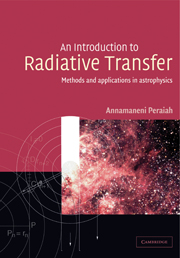Book contents
- Frontmatter
- Contents
- Preface
- Chapter 1 Definitions of fundamental quantities of the radiation field
- Chapter 2 The equation of radiative transfer
- Chapter 3 Methods of solution of the transfer equation
- Chapter 4 Two-point boundary problems
- Chapter 5 Principle of invariance
- Chapter 6 Discrete space theory
- Chapter 7 Transfer equation in moving media: the observer frame
- Chapter 8 Radiative transfer equation in the comoving frame
- Chapter 9 Escape probability methods
- Chapter 10 Operator perturbation methods
- Chapter 11 Polarization
- Chapter 12 Polarization in magnetic media
- Chapter 13 Multi-dimensional radiative transfer
- Symbol index
- Index
Chapter 6 - Discrete space theory
Published online by Cambridge University Press: 05 June 2012
- Frontmatter
- Contents
- Preface
- Chapter 1 Definitions of fundamental quantities of the radiation field
- Chapter 2 The equation of radiative transfer
- Chapter 3 Methods of solution of the transfer equation
- Chapter 4 Two-point boundary problems
- Chapter 5 Principle of invariance
- Chapter 6 Discrete space theory
- Chapter 7 Transfer equation in moving media: the observer frame
- Chapter 8 Radiative transfer equation in the comoving frame
- Chapter 9 Escape probability methods
- Chapter 10 Operator perturbation methods
- Chapter 11 Polarization
- Chapter 12 Polarization in magnetic media
- Chapter 13 Multi-dimensional radiative transfer
- Symbol index
- Index
Summary
Introduction
We have studied homogeneous, plane parallel scattering atmospheres in chapter 5, using the principles of invariance in semi-infinite and finite media. These problems are solvable by the standard techniques of differential equations and expressible in standard functions. The X- and Y-functions of Chandrasekhar are solutions of certain integral equations. These cannot be used in a non-homogeneous media unless one sacrifices the physical characteristics of the medium. These solutions have been tabulated and it is difficult to use them in practical problems. One has to make serious physical approximations or resort to a numerical approximation. The principles of invariance are essentially the statement of the conservation of energy. Conservation of energy in a finite region can be expressed by what is called the ‘interaction principle’. In the limit of vanishing thickness of the medium these principles lead to the integro-differential equations of radiative transfer. The principle of interaction (see Redheffer (1962), Preisendorfer (1965), Grant and Hunt (1969b)) generalizes the invariance principles particularly in a finite medium. The basic idea of the interaction principle is to specify the radiation field in terms of the transmitted and reflected radiation at any given point in the medium.
Carlson (1963) and Lathrop and Carlson (1967) used a numerical version of the discrete ordinate technique in neutron reactor calculations. By integrating the radiative transfer equation over a finite volume in space coordinates and using the mean value theorem for integrals, we can develop difference equations that conserve flux.
Information
- Type
- Chapter
- Information
- An Introduction to Radiative TransferMethods and Applications in Astrophysics, pp. 146 - 192Publisher: Cambridge University PressPrint publication year: 2001
